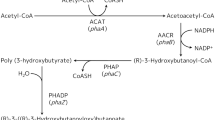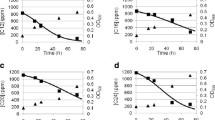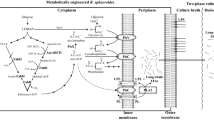Abstract
The OCT plasmid from Pseudomonas maltophilia N246-1 was transferred to Rhodopseudomonas sphaeroides M1 with very low frequency (1.4–1.9 × 10−5 per recipient cell at pH 7–8 for a 3-hour reaction time). P. maltophilia N246-1 was able to utilize C8-C14 of n-alkanes, whereas R. gas-liquid chromatography determined that the broad range of carbon numbers of n-alkanes in crude oil was remarkably degraded by the transconjugant, R. sphaeroides M1-C1, compared with donor strain N246-1. The fact that donor and transconjugant strains simultaneously lost the capacity to utilize n-alkanes on L-broth medium suggests that the OCT plasmids are unstable. It was found that the OCT plasmid of P. maltophilia N246 was incompatible with the IncP-2 group of P. aeruginosa KCTC 11245.
Similar content being viewed by others
References
Baptist JN, Gholson RK, Coon MJ (1963) Hydrocarbon oxidation by a bacterial enzyme system. I. Products of octane oxidation. Biochem Biophys Acta 69:10–17
Cerda-Olmeda E, Hanawalt PC, Guerola N (1968) Mutagenesis of the replication point by nitrosoguanidine: map and pattern of replication of Escherichia coli chromosome. J Mol Biol 33:705–719
Chakrabarty AM (1972) Genetic basis of the biodegradation of salicylate in Pseudomonas. J Bacteriol 112:815–823
Chakrabarty AM, Friello DA (1974) Dissociation and interaction of individual components of a degradative plasmid aggregate in Pseudomonas. Proc Natl Acad Sci USA 71:3410–3414
Chakrabarty AM, Chou GN, Gunsalus IC (1973) Genetic regulation of octane dissimilation plasmid in Pseudomonas. Proc Natl Acad Sci USA 70:1137–1140
Choi SY, Kim CS, Lee MH, Hwang MO, Min KH (1991) Octane biodegradability by crude oil utilizing bacteria carrying OCT plasmid. Kor J Appl Microbiol 19:82–87
Chou GIN, Katy N, Gunsalus IC (1974) Fusion and compatibility of camphor and octane plasmids in Pseudomonas. Proc Natl Acad Sci USA 71:2675–2678
Dunn NW, Gunsalus IC (1973) A transmissible plasmid coding for napthalene oxidation in Pseudomonas putida. J Bacteriol 114:974–979
Eggink G, Lageveen RG, Altenberg B, Witholt B (1987) Controlled and functional expression of the Pseudomonas oleovorans alkane utilizing system in Pseudomonas putida and Escherichia coli. J Biol Chem 262:17712–17718
Hansen JB, Olsen RH (1978) IncP2 group of Pseudomonas, a class of uniquely large plasmids. Nature 274:715–717
Kho YH, Chun HK, Cho KY, Bae KS (1989) Conjugal transfer of NAH, TOL, and CAM::TOL plasmid into n-alkane assimilating Pseudomonas putida. Kor J Appl Microbiol Bioeng 17:51–55
Kim SH, Kim CS, Cho IS, Choi SY, Min KH (1990) Microbial degradation of alkane components in crude oil. Kor J Microbiol 20:71–75
Kok M, Oldenhuis R, van der Linden MPS, Meulenberg CHC, Kingma J, Witholt B (1989) The Pseudomonas oleovorans alkBAC operon encodes two structurally related rubredoxins and an aldehyde dehydrogenase. J Biol Chem 264:5442–5451
Nakazawa T, Inouye S, Nakazawa A (1980) Physical and functional mapping of RP4:TOL plasmid recombinants analysis of insertion and deletion mutants. J Bacteriol 144:222–231
Rheinwald JG, Chakrabarty AM, Gunsalus IC (1973) A transmissible plasmid controlling camphor oxidation in Pseoudomonas putida. Proc Natl Acad Sci USA 70:885–889
Sayler GS, Hooper SW, Layton AC, King JMH (1990) Catabolic plasmids of environmental and ecological significance. Microb Ecol 19:1–20
Wheelis ML (1975) The genetics of dissimilative pathways in Pseudomonas. Annu Rev Microbiol 29:505–524
Author information
Authors and Affiliations
Additional information
Offprint requests to: K.-H. Min, Sookmyung Women's University.
Rights and permissions
About this article
Cite this article
Lee, M.H., Hwang, M.O., Choi, S.Y. et al. n-Alkane dissimilation by Rhodopseudomonas sphaeroides transferred OCT plasmid. Microb Ecol 26, 219–226 (1993). https://doi.org/10.1007/BF00176954
Received:
Revised:
Issue Date:
DOI: https://doi.org/10.1007/BF00176954




